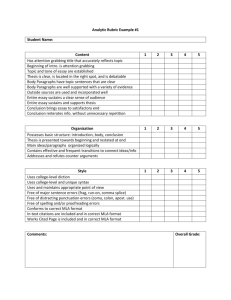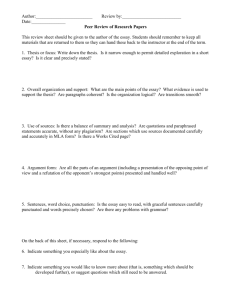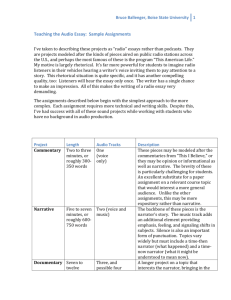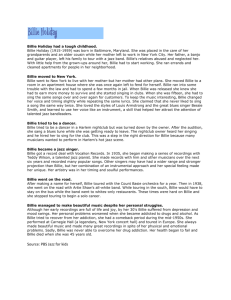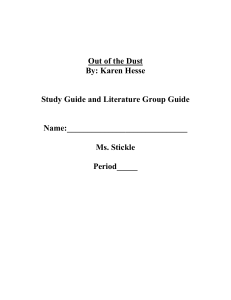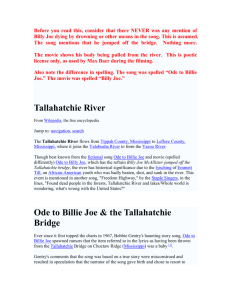Assignment Sheet
advertisement
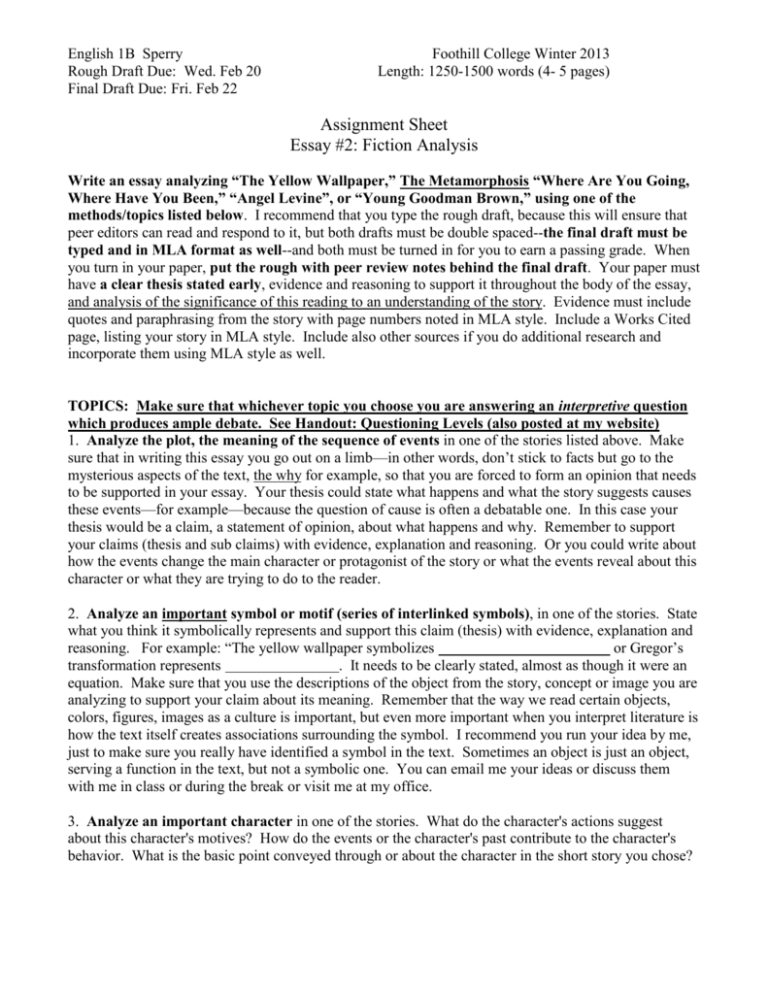
English 1B Sperry Rough Draft Due: Wed. Feb 20 Final Draft Due: Fri. Feb 22 Foothill College Winter 2013 Length: 1250-1500 words (4- 5 pages) Assignment Sheet Essay #2: Fiction Analysis Write an essay analyzing “The Yellow Wallpaper,” The Metamorphosis “Where Are You Going, Where Have You Been,” “Angel Levine”, or “Young Goodman Brown,” using one of the methods/topics listed below. I recommend that you type the rough draft, because this will ensure that peer editors can read and respond to it, but both drafts must be double spaced--the final draft must be typed and in MLA format as well--and both must be turned in for you to earn a passing grade. When you turn in your paper, put the rough with peer review notes behind the final draft. Your paper must have a clear thesis stated early, evidence and reasoning to support it throughout the body of the essay, and analysis of the significance of this reading to an understanding of the story. Evidence must include quotes and paraphrasing from the story with page numbers noted in MLA style. Include a Works Cited page, listing your story in MLA style. Include also other sources if you do additional research and incorporate them using MLA style as well. TOPICS: Make sure that whichever topic you choose you are answering an interpretive question which produces ample debate. See Handout: Questioning Levels (also posted at my website) 1. Analyze the plot, the meaning of the sequence of events in one of the stories listed above. Make sure that in writing this essay you go out on a limb—in other words, don’t stick to facts but go to the mysterious aspects of the text, the why for example, so that you are forced to form an opinion that needs to be supported in your essay. Your thesis could state what happens and what the story suggests causes these events—for example—because the question of cause is often a debatable one. In this case your thesis would be a claim, a statement of opinion, about what happens and why. Remember to support your claims (thesis and sub claims) with evidence, explanation and reasoning. Or you could write about how the events change the main character or protagonist of the story or what the events reveal about this character or what they are trying to do to the reader. 2. Analyze an important symbol or motif (series of interlinked symbols), in one of the stories. State what you think it symbolically represents and support this claim (thesis) with evidence, explanation and reasoning. For example: “The yellow wallpaper symbolizes or Gregor’s transformation represents . It needs to be clearly stated, almost as though it were an equation. Make sure that you use the descriptions of the object from the story, concept or image you are analyzing to support your claim about its meaning. Remember that the way we read certain objects, colors, figures, images as a culture is important, but even more important when you interpret literature is how the text itself creates associations surrounding the symbol. I recommend you run your idea by me, just to make sure you really have identified a symbol in the text. Sometimes an object is just an object, serving a function in the text, but not a symbolic one. You can email me your ideas or discuss them with me in class or during the break or visit me at my office. 3. Analyze an important character in one of the stories. What do the character's actions suggest about this character's motives? How do the events or the character's past contribute to the character's behavior. What is the basic point conveyed through or about the character in the short story you chose? Presentation of Secondary Source Directions for Secondary Source Presentation: The Presentations will be 7 minutes long maximum: 1. Summarize the reading, telling the class what it basically argues or reveals about the story or its author. 2. Connect this reading to the story, explaining how it influences your understanding of the story. For example, if you were to connect Ron Carlson’s “The Something File” to “Ode to Billie Joe” you might make statements such as: Carlson’s claim in “The Something File” that putting a frog down the narrator’s back is “hardly flirting” made me realize that it could actually have been flirting and caused me to pay attention to all the signs that the narrator and Billie Joe had been seen a lot together and might therefore have been romantically involved. 3. Critique the reading, explaining how useful and valid it is, being as specific as you possibly can. For example, if you were to critique Ron Carlson’s “The Something File” you might say, “His close examination of the idea that Billie Joe and the narrator of ‘Ode to Billie Joe’ threw a baby off the bridge helped me understand that a common reading of the story when the song came out was that they threw a baby off the bridge. It also showed us how to use real life, the text, and reasoning to interpret texts. I became convinced that a) they didn’t throw a baby off the bridge and b) they were having some kind of secret relationship that caused Billie Joe to jump off the bridge, perhaps because the narrator broke up with him. (You will state your own opinion, explaining how you found the reading helpful to your understanding of “The Yellow Wallpaper”) The humorous tone of the reading was entertaining, but it undermined Carlson’s legitimacy in places. For example when he questions whether the priest can identify the narrator, which bridge Billie Joe jumped from and even whether he jumped or slipped, that isn’t particularly useful. It’s funny, but since we are dealing with a song where the meaning is highly controlled, these questions aren’t particularly useful. For example, even though he questions whether the narrator was really on the bridge or not, the song suggests strongly that she was because she is silent when her mother brings up her possible location with him and because the narrator goes there later, which strongly suggests she was the one there with him. The pattern of questions about her being seen with him, her silence and loss of appetite, and her visits to the bridge a year later, all strongly suggest she was somehow involved with Billie Joe. Still, having Carlson question this helped me understand what I needed to argue in my paper. Also, I basically agree with him that they didn’t throw a baby off the bridge.
